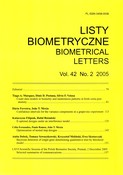
Listy Biometryczne - Biometrical Letters vol. 42(2), 2005, pp. 81-112


|
COUNT DATA MODELS IN BIOMETRY AND RANDOMNESS PATTERNS IN BIRDS EXTRA-PAIR PATERNITY Tiaro A. Marques, Dinis D. Pestana, Silnio F. Velosa Universidade de Lisboa, Centro de Estatística e Aplicaçőes da Universidade de Lisboa, +351-21-7500040, dinis.pestana@fc.ul.pt |

The number of extra pair nestlings ina brood is the basic information to investigate extra-pair fertilization in socially monogamous birds, an interesting pattern of behaviour that has been observed in some species. Under unconstrained randomness, Poisson streams of events are expected. But other patterns of randomness may arise, suggesting new research questions. Starting from a coordinated approach to count models, we discuss Zipf-Mandelbrot self-organizing scaling laws, which are typical of phenomena shaped as a result of conflicting interests, and some extensions of Mandelbrot's model. While the traditional count models (Poisson, binomial, negative binomial or hypergeometric) seem inappropriate, the logarithmic, truncated logarithmic, Zipf--Mandelbrot and discrete lognormal models consistently provide the best fit to the available data, indicating that probably some females are more prone than others to have extra pair nestlings. This suggests a delicate balance: the number of extra pair nestlings in the progeny is the result of conflicting behaviours, the search for genetic diversity and the need to ensure male cooperation in raising the brood.

Count data, extra-pair fertilization, goodness-of-fit, Poisson related and Zipf-Mandelbrot related models, randomness.
